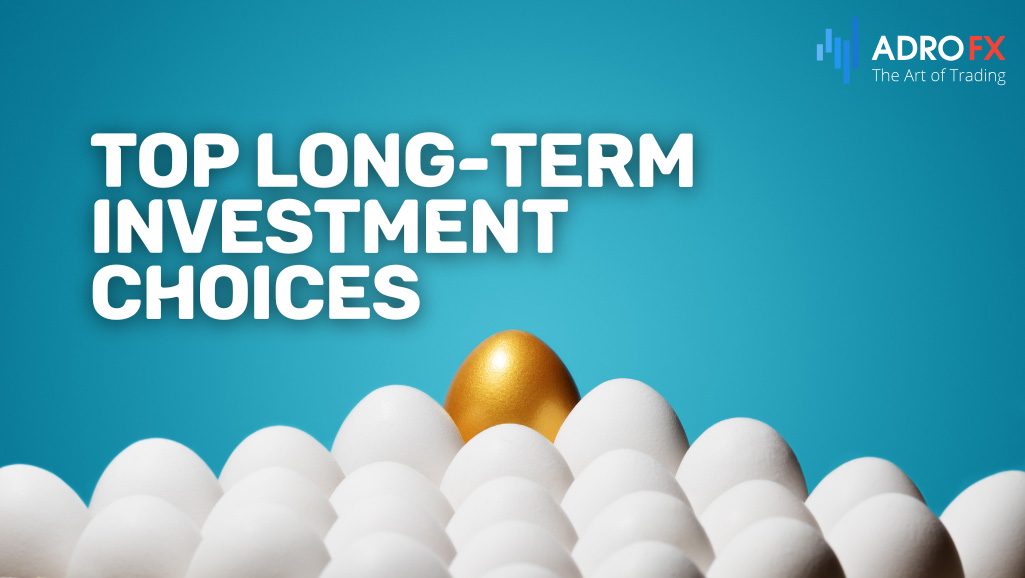Long-Term Investment Strategies: Building Wealth for the Future

Have you ever considered that the S&P 500 has averaged around a 10% annual return over the past nine decades? This remarkable statistic highlights the effectiveness of long-term investment strategies in wealth accumulation. Unlike short-term trading, long-term investing focuses on gradually increasing your assets through the power of compounding and market growth.
For those aiming for financial stability and security, adopting a long-term investment approach is vital. This involves holding investments - such as stocks, bonds, or real estate - over extended periods, allowing them to weather market fluctuations and benefit from economic progress. By prioritizing long-term objectives, you lay a strong foundation for lasting wealth, ideal for those seeking financial independence and a secure future.
Understanding the principles of long-term investing and implementing effective strategies can help you avoid impulsive decisions and short-term distractions, keeping your focus on achieving sustained wealth.
Why Long-Term Investments Are Crucial for Wealth Building
Long-term investments play a pivotal role in wealth creation for several reasons, with compound returns being a major advantage. Compounding allows your returns to generate additional earnings, resulting in exponential growth. The longer your investment horizon, the more pronounced the benefits of compound interest, leading to significant wealth accumulation.
For example, if you invest $10,000 at an annual interest rate of 8%, your investment grows to $10,800 in the first year. In the second year, interest is earned on $10,800, not just the initial $10,000, increasing the value to $11,664. This compounding effect accelerates wealth accumulation over time, and its impact becomes even more significant over decades, making long-term investments highly effective for building substantial wealth.
Another benefit of long-term investing is its potential to reduce risk. While short-term market fluctuations can be unpredictable, historical data shows that markets tend to rise over time. Holding investments for longer periods allows you to navigate through volatility and avoid making hasty decisions during downturns. This patience and commitment help you avoid common investment mistakes, such as panic selling during market declines.
Successful long-term wealth accumulation requires a disciplined approach, adhering to your investment plan through market fluctuations. When combined with the advantages of compound interest, long-term investing offers a reliable path to financial growth and the realization of your goals.

Top Long-Term Investment Choices
When considering the best long-term investments, it’s crucial to evaluate options based on risk tolerance, growth potential, and alignment with your overall financial strategy. Here are some of the most reliable choices for long-term investors:
Stock Market
The stock market remains a popular choice for long-term investors, offering numerous ways to build wealth. Index funds and ETFs (Exchange-Traded Funds) are notable for their broad market exposure. Index funds track major indices like the S&P 500, which has delivered an average annual return of around 10% over the past 90 years. These funds are cost-effective and inherently diversified, making them an accessible option for beginners and a key element of any seasoned investor’s portfolio.
ETFs operate similarly to index funds but offer greater flexibility, as they can be traded like individual stocks. For those who prefer a more hands-on approach, investing in individual stocks can be rewarding if you conduct thorough research and focus on companies with strong growth potential. However, individual stocks carry more risk and should be balanced with safer investments, particularly in a long-term strategy.
Real Estate
Real estate is another robust option for long-term investing, known for consistent returns through property appreciation and rental income. It provides a tangible asset that not only generates cash flow but also serves as a hedge against inflation. Over time, property values typically increase, making real estate a cornerstone of many long-term wealth-building portfolios.
Real estate investment methods include purchasing residential or commercial properties or investing in Real Estate Investment Trusts (REITs), which offer a way to invest in real estate without direct management. Leveraging real estate through mortgages can enhance its potential as a long-term wealth builder, though it’s important to account for property maintenance, taxes, and other associated costs.
When investing in real estate, consider factors such as location, property condition, and market trends. Properties in growing or high-demand areas tend to appreciate faster and attract more reliable tenants. Additionally, understanding local real estate markets and regulations can improve your investment decisions and outcomes.
Bonds
Bonds are considered the safety net of an investment portfolio. They provide stable, fixed income and are less volatile than stocks, making them ideal for investors who prioritize security or are nearing retirement. Government bonds, such as US Treasury bonds, are generally the safest but offer lower returns. Corporate bonds offer higher yields but come with added risk.
Incorporating bonds into your portfolio helps cushion stock market fluctuations, offering steady returns and protecting against extreme volatility. For beginners, bonds can be particularly useful in maintaining portfolio balance and stability over time.
When investing in bonds, evaluate the credit rating of the issuer, as this affects the bond's risk level. Higher-rated bonds (e.g., AAA) are less risky but offer lower yields, while lower-rated bonds (e.g., junk bonds) provide higher returns but come with increased risk. Diversifying your bond holdings across different issuers and maturities can also help manage risk.
Retirement Accounts (401(k), IRAs)
Retirement accounts such as 401(k)s and IRAs are essential for growing wealth tax-efficiently. These accounts offer significant tax benefits. Contributions to traditional IRAs and 401(k)s are tax-deductible, and earnings grow tax-deferred until retirement. Roth IRAs involve after-tax contributions, but withdrawals in retirement are tax-free.
Retirement accounts enable consistent investment over decades and take advantage of employer matching programs, in the case of 401(k)s. This type of compounding can transform modest contributions into substantial sums over time, making them a powerful tool for long-term financial success.
When utilizing retirement accounts, consider your retirement timeline and the investment options available within the account. Traditional accounts may be advantageous for those expecting lower tax rates in retirement, while Roth accounts are beneficial for those anticipating higher future taxes. Regularly review and adjust your investment choices based on your retirement goals and risk tolerance.
Also read: Dip Buying Mastery: A Strategic Approach to Capitalizing on Market Dynamics

Developing a Long-Term Investment Plan
Formulating a long-term investment plan involves detailed preparation and consistent execution. Whether you're just starting out or fine-tuning your existing strategy, these steps will steer you toward sustainable financial growth:
Identify Your Financial Objectives and Risk Appetite
Before embarking on your investment journey, it's essential to define your objectives and assess your risk appetite. Clarify what you want to achieve - whether it's preparing for retirement, purchasing a property, or supporting education expenses. Well-defined goals will direct your investment choices and help maintain focus during market fluctuations.
Equally important is understanding your risk tolerance. Younger investors, who have a longer time horizon, can generally afford to take on more risk. In contrast, those approaching retirement may prefer a more conservative strategy, emphasizing capital preservation through bonds and other low-risk investments.
For instance, if you plan to retire in 30 years, a portfolio with a higher allocation to stocks may be suitable, given their potential for higher long-term returns despite short-term volatility. Conversely, if you are close to retirement and seek to preserve your assets, shifting towards bonds and dividend-paying stocks may reduce risk and offer a stable income stream.
Diversify Your Investments
Diversification is crucial for any long-term investment plan. It involves spreading your investments across different asset classes - such as equities, fixed income, and real estate - to minimize risk. Diversification helps prevent poor performance in one area from severely affecting your overall portfolio.
For example, if equities underperform during an economic downturn, your bonds or real estate investments might still generate positive returns or mitigate losses. This balanced approach helps navigate market volatility and improves overall returns.
Moreover, consider diversifying within asset classes. For stocks, this means investing in various sectors and industries. For bonds, it involves holding different types with varied maturities and credit ratings. Diversification protects your portfolio from the negative impact of any single investment's poor performance.
A robust portfolio might include a blend of domestic and international stocks, government and corporate bonds, and real estate holdings. By spreading investments across asset classes and geographic regions, you minimize the risk associated with any single investment or market.
Implement Dollar-Cost Averaging
Dollar-cost averaging is a strategy where you invest a fixed amount at regular intervals, irrespective of market conditions. This method allows you to purchase more shares when prices are low and fewer when they are high, effectively lowering your average cost per share over time.
This approach reduces the emotional impact of market volatility and is especially advantageous for novice investors. It minimizes the effect of short-term market fluctuations and maintains a focus on long-term wealth accumulation.
Using dollar-cost averaging helps maintain discipline and avoid the pitfalls of market timing, which can be challenging even for seasoned investors. By investing regularly, you establish a consistent saving and investing habit, vital for long-term success.
To leverage dollar-cost averaging effectively, set up automatic contributions to your investment accounts. This ensures consistent investment and helps resist the urge to make impulsive decisions based on market movements.
Regularly Rebalance Your Portfolio
Over time, some investments may outperform others, leading your portfolio to deviate from its original allocation. For example, if stocks outperform bonds, your portfolio may become overweight in stocks. To maintain your desired risk level, regularly rebalance your portfolio.
Rebalancing involves selling portions of overperforming assets and reinvesting in underperforming ones. This practice helps maintain your risk tolerance and capitalizes on growth opportunities in undervalued assets. Rebalancing ensures adherence to your long-term investment strategy and promotes steady growth.
Choose a rebalancing frequency that aligns with your investment style and market conditions. Some investors rebalance annually, while others may opt for quarterly or semi-annual adjustments. Additionally, consider rebalancing in response to significant market events or changes in personal circumstances, such as a shift in financial goals or risk tolerance.
Review and Adjust Your Strategy
Long-term investing requires continuous attention. Regularly review your investment portfolio, monitor its performance, and adjust your strategy as needed based on changes in your goals or market conditions. Conducting annual reviews or quarterly check-ins can help keep you on track and make necessary adjustments.
Monitoring involves evaluating your investments' performance against your objectives and making changes as required. For instance, if your risk tolerance shifts due to life events like marriage or retirement, you may need to adjust your asset allocation to align with your revised goals.
Stay informed about market trends and economic factors that could affect your investments. While it's important to avoid overreacting to short-term market fluctuations, staying well-informed ensures you can make educated decisions and adapt your strategy as necessary.
Also read: Maximizing Trading Performance: Strategies to Overcome Distracting Factors

Benefits of Long-Term Investing
Long-term investing offers numerous benefits, making it an attractive option for wealth accumulation:
- Compounding Returns
The power of compounding means that your investments generate earnings on previous earnings. This exponential growth can significantly increase your wealth over time. For example, a $10,000 investment growing at an annual rate of 7% will double approximately every 10 years.
Compounding benefits are particularly pronounced in tax-advantaged accounts like IRAs and 401(k)s, where your investments grow without immediate tax implications. This allows for more rapid wealth accumulation and maximizes the impact of compounding over long investment horizons.
- Reduced Impact of Market Volatility
Long-term investing helps smooth out the effects of market volatility. Short-term market fluctuations can be unsettling, but a long-term perspective allows you to weather these ups and downs. Historical data shows that markets tend to rise over time, making long-term investments less susceptible to temporary market disruptions.
- Lower Transaction Costs
Long-term investing typically involves fewer transactions, reducing trading fees and commissions. This cost-efficiency enhances overall returns, as frequent trading can erode profits through transaction costs. By focusing on long-term growth and minimizing trading activity, you maximize the benefits of your investments.
-
Tax Efficiency
Holding investments for longer periods can be more tax-efficient. Long-term capital gains - profits from investments held for more than one year - are generally taxed at lower rates than short-term gains. This tax advantage contributes to higher net returns and enhances overall investment outcomes.
Common Mistakes to Avoid in Long-Term Investing
Avoiding common pitfalls is crucial for long-term investing success. Here are some key mistakes to steer clear of:
- Emotional Investing
Allowing emotions to dictate investment decisions can lead to costly errors. Fear and greed often drive impulsive actions, such as selling during market downturns or chasing after hot stocks. Such behavior can undermine long-term success.
Maintain a disciplined approach by sticking to your investment strategy and focusing on long-term goals. Regularly review your portfolio and make adjustments based on your plan, not market emotions. Emotional investing often results in buying high and selling low, which can significantly reduce overall returns.
- Attempting to Time the Market
Trying to predict market peaks and troughs is notoriously difficult and often results in suboptimal outcomes. Investors who attempt to time the market may miss significant gains or suffer losses from poorly timed decisions.
Adopt a long-term perspective and avoid frequent trading based on market predictions. Instead, focus on your investment strategy and allow your investments to grow over time. Market timing requires precise predictions, which are challenging even for experts, and can lead to missed opportunities and increased transaction costs.
- Neglecting Diversification
Concentrating investments in a single asset class or sector increases risk. Failure to diversify can lead to significant losses if that asset class underperforms. Ensure your portfolio includes a mix of assets to manage risk and achieve more stable returns.
Regularly assess your portfolio and adjust as needed to maintain diversification. Diversification helps protect against market volatility and enhances overall portfolio stability. A well-balanced portfolio should include a variety of asset classes, sectors, and geographic regions to reduce risk and optimize returns.
- Ignoring Fees and Expenses
Investment fees and expenses can erode long-term returns. High management fees, trading costs, and other expenses can significantly impact your investment growth. Opt for low-cost investment options and be mindful of fees associated with your investments.
Review your investment accounts and fees periodically. Consider using low-cost index funds or ETFs to minimize expenses and maximize your returns. High fees can dramatically reduce overall returns over time, making it essential to choose investment options with reasonable costs.
Also read: Tailored Investments: Leveraging Your Risk Tolerance for Optimal Return
Conclusion
Implementing effective long-term investment strategies is key to achieving lasting financial success. By understanding the benefits of compound interest, diversifying your portfolio, and avoiding common mistakes, you can build substantial wealth over time. Start planning today and work towards a secure and prosperous financial future.
Embrace a disciplined approach to investing, focus on long-term goals, and leverage the power of compound interest to maximize your wealth. Remember, successful investing is a marathon, not a sprint. By staying committed to your strategy and avoiding common pitfalls, you can achieve your financial objectives and enjoy a secure, prosperous future.
Ready to start your journey toward long-term financial success?
Explore the benefits of disciplined investing with AdroFx. Whether you're looking to dive into the stock market, real estate, or bonds, AdroFx provides the tools and insights you need to make informed decisions and grow your wealth effectively.
Sign up for a free demo account today and see how AdroFx can help you build a successful long-term investment strategy. Start planning for your financial future with confidence, backed by expert support and a comprehensive suite of trading tools.
About AdroFx
Established in 2018, AdroFx is known for its high technology and its ability to deliver high-quality brokerage services in more than 200 countries around the world. AdroFx makes every effort to keep its customers satisfied and to meet all the trading needs of any trader. With the five types of trading accounts, we have all it takes to fit any traders` needs and styles. The company provides access to 115+ trading instruments, including currencies, metals, stocks, and cryptocurrencies, which make it possible to make the most out of trading on the financial markets. Considering all the above, AdroFx is the perfect variant for anyone who doesn't settle for less than the best.










